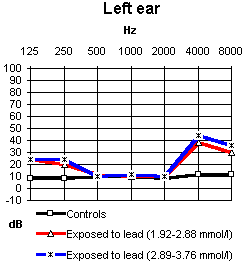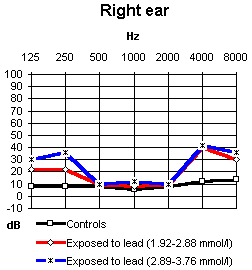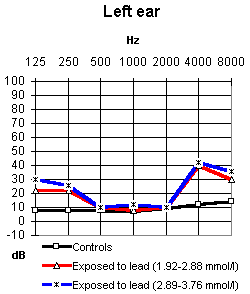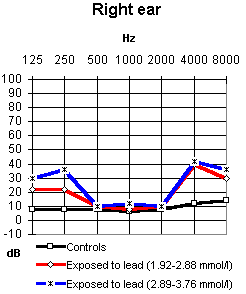

|
Journal Home Contents Preview Next |
Pro Otology
Balkan Journal of Otology & Neuro-Otology, Vol. 2, No 1:18-21 © 2002
All rights reserved. Published by Pro Otology Association
Disturbances in Hearing Vestibular-Auditory Interactions of Persons, Occupationally Exposed to Lead
A. Savov, A. Kamenova, M. Antonov
Department of Otorhinolaryngology and Otoneurology,University Hospital "St. Ivan Rilski", Sofia, Bulgaria
ABSTRACT
Objective: The aim of this work is to study the audition and the perception during invoked vestibular crisis in workers exposed to lead in its capacity of factor of the working environment.
Study Design: This study was designed as a prospective clinical study.
Setting: The study was performed in the University Hospital "St.Ivan Rilski", Departament of Otorihnolaringology and Otoneurology, Sofia, Bulgaria.
Patients: The study is performed on 56 workers exposed to lead and 28 controls.
Intervention: Threshold and above-threshold audiometry.
Methods: The study involve targeted anamnesis, oto-rhino-laringological examination, threshold tonal (air and bone), above- threshold audiometry (differential threshold audibility (DTA) test after Leuscher-Zvysloki, SISI-test, Karhdrdt's adaptation test, Kitz's redaptation test), determination of lead in blood and urine before and after antidote therapy with CaNa2EDTA by atomic absorbtion spectrophotometry.
Results: The results from the studies of vestibular effect on hearing function relate to changes in time perception, as well as to altereted perception of sound intensity, frequency and spatial localization.
Conclusions: An audiometric curve of "convex" type is revealed mainly involving frequences of 4000 and 8000 Hz under the effect of toxic and noise factors. Theincidence of changes in perception of time, intesity and spatial sound localisation is significantly greater in workers exposed to lead without "dose-effect" relationship.
Key Words: Lead, Hearing function, Vestibular function.
Pro Otology 1: 18-21, 2002
INTRODUCTION
The neurotoxic potential of lead could be discussed as a factor injuring the higher specialized sensibility. There are numerous studies on the neurotropic effect of lead (7,8,9,10,11,12,14,15). There is evidence for injured hearing function (1,4,13), vestibular analyzer (5), vision function (16) under lead impact. There are, though, no data on changes in the interaction of these analyzers, responsible for the accurate perception of spatial continuum.
The aim of this work is to study the audition and the hearing perception during invoked vestibular crisis in workers exposed to lead in its capacity of factor of the working environment.
MATERIAL AND METHODS
The study covers 56 workers exposed to lead (mainly from printing and battery production). The mean age is 36.5 ± 6.3 years (maximal - 45 years) and the mean length of specialized service is 16.1 ± 7.1 years. The workers do not report history of past diseases of the nervous system, including brain traumas, otic diseases, arterial hypertension, as well as etylism. The study does not involve printing operators exposed to toluene and workers from battery production exposed to cadmium.
The control group consists of 28 persons (mean age 38.7 ± 5.2 years), clinically healthy, without exposure to toxic, physical, mechanical and other factors of the working environment which could affect the higher specialized sensibility.
The toxico-chemical studies comprise: determination of lead in blood and urine before and after antidote therapy with CaNa2EDTA by atomic absorption spectrophotometry. The studies involve targeted anamnesis, oto-rhino-laryngological examination, threshold tonal (air and bone) and above-threshold audiometry (differential threshold audibility (DTA) test after Luescher-Zvysloki, SISI-test, Karhardt's adaptation test and Kitz's readaptation test) (2). The vestibular-auditory interaction is studied at invoked vestibular crisis by a psychophysiological method (3).
This method scenario is as follows: the examined person sits on a chair with the head supported in supine position backwards at 30°. An electronic stimulator via a loudspeaker transmits sound impulse with the following parameters - period of repeating - 300 msec, duration - 20 msec, intensity - 65 dB, frequency 3500 Hz, sound source localization at 0° horizontal and 25° vertical. The loudspeaker is mounted on a graduated circumference, behind the person, with the zero point lying on the median (crossing of both circumferences). The stimulator is connected with a recorder and the studied person follows the rhythm fed by the electrostimulator by pressing a button, connecting both devices. Before the caloric provocation the studied individual gets into the rhythm and records the transmitted sound impulse parameters. Caloric vestibular irritation is invoked (introduction of 10 ml of water at 20°C for 10 sec successively in the left and right ear canal). After the vegetative phenomena of the vestibular crisis have vanished, the occurred subjective deviations in the perception of the transmitted signal are recorded, i.e. the person has again to follow the rhythm of the supplied sound impulse. The eventual spatial changes in the intensity, frequency and localization of the sound are also recorded. A special device is used to record the occurred changes in vestibular-auditory motion time of the studied individual.
The results are processed statistically by variation and alternative analysis and for statistical significance by Student-Fisher's t-criterion (p < 0.05).
RESULTS AND DISCUSSION
The mean concentration of lead in blood (PbB) in exposed workers is 2.74 ± 0.26 µmol/l vs. 0.44 ± µmol/l in the control group (p < 0.001). The basal plumburia in the exposed group is 0.50 ± 0.21 vs. 0.11 ± 0.08 µmol/l in the control group.
Based on personal toxico-chemical analysis two groups of workers are formed: I group (42 persons) with admissible absorption of lead in blood (1.92 - 2.88 µmol/l) (6); II group - 14 workers with absorption of lead in blood exceeding the admissible (2.89 - 3.76 µmol/l).
The otoneurological studies are performed before the antidote therapy. The analysis of the anamnesis data reveal prevalence of vertigo and dizziness, particularly frequent at work (60.7% of the workers). Such deviations are reported mainly as incidental dizziness by 17.8% of the control group. The rate of vertigo complaints is greater for workers with higher degree of lead absorption (64.2%) vs. 59.5% for workers with admissible lead absorption, though these differences are not statistically significant (p > 0.05).
The audiometric tests show that there is only one case with occupational otic neuritis. The averaged audiometric curves of both exposed groups are convex. The average values of the hearing threshold for air and bone conductivity are the greatest at frequency of 4000 Hz followed by 8000 Hz, symmetrical for the two ears. The average values are lower for frequencies of 125 and 250 Hz (Fig. 1 and Fig. 2). The above-threshold tests (DTA, SISI) show that the frequency of 4000 Hz is of concern for both exposed groups. Karhardt's test reveals deteriorated adaptation abilities at 4000 Hz. This positivization of Karhardt's test and the similar changes in Kitz's readaptation test can be due to the effect of occupational noise which varies between 82 and 88 dB/A in printing halls and battery production. The full-shift exposure to such noise levels can lead to hearing deviations.
Changes in time perception at provocation of the left labyrinth are found in 64.3% of the workers from group I and in 66.7% at right labyrinth provocation in the same group. The second group shows equal changes in time perception at left and right labyrinth provocation (57.2%) (Table 1). No significant differences between the two exposed groups are revealed. Lagging in time is prevailing among exposed individuals. The cases with deviations exceeding the mean values of the delay are respectively 102.7 msec for left and 110.0 msec for right labyrinth (I group) and 112.6 for left and 110.0 for right labyrinth (II group). "Accelerating" time is less observed (Table 1).

|

|
|
|
FIG. 1. Total threshold audiometry. Air conductivity. |
||

|

|
|
|
FIG. 2. Total threshold audiometry. Bone conductivity. |
||
CONCLUSIONS
1. The personal toxico-chemical analysis differentiates two groups of workers - 42 persons with admissible level of lead in blood (1.92 - 2.88 µmol/l) and 14 persons exceeding the admissible level (2.89 - 3.76 µmol/l).
2. An audiometric curve of "convex" type is revealed mainly involving frequencies of 4000 and 8000 Hz under the effect of toxic and noise factors.
3. The incidence of changes in perception of time, intensity and spatial sound localization is significantly greater in workers exposed to lead, without "dose-effect" relationship.
4. The deviations in time perception during a vertigo crisis are manifested mainly by time lagging and decreased sound intensity. This could provoke unreal assessment and inadequate attitude of the worker towards the working environment with all sequences of uncontrolled emergencies and possible work accidents.
REFERENCES
Betov A. Toxic injuries of the heating organ. In: Occupational deseases in otorhinolaryngology, Sofia: Medicina i fizcultura, 1981:66-72.
Chiang W. Otolaryngologic Principles. In: The Pathophysiolojic basis of medical toxicology. Phyladelphia: 1992:457-62.
Jacobsen P. Chemically-induced hearing disorders. In :Encyclopaedia of Occupational Health and Safety. 1999:7-11.
Kehaiov A. Space, time, motion. Sofia: Medicina i fizcultura, 1978:178.
Muller C. et al. Otoneurological Findings in Psycho-organic Syndrome Caused by Indusrtial Solvent Exposure. Acta Otolaryngol ( Stockh) 1989;107:5-12.
Rybak L. Hearing: The effects of chemicals. Otolaryngol Head Neck surg 1992;106:677-9.
Niklasson M, Moller C, Odkvist LM. Are deficits in the equilibrium system relevant to the clicalinvestigation of solvent-induced neurotoxicity? Scand J Work Environ Health 1997;23(3):206-13.
Ledin T et al. Effects of alcohol in modified dynamic posturography and randomized perturbed posturography. Acta Otolaryngol (Stockh) 1993;33:1-7.
Ledin T, Jansson E. Chronic toxic encephalopathy investigated using dynamic posturography. Am J Otolaryngol 1991;12:96-100.
Lillienthal H et al. Effects of lead on neurophysiological and performance measures: animal and human data. Environ Health Perspect 1990;89:21-5.
Goyer RA. Nutrition and metal toxicity. Am J Clin Nutr 1995;61:646-50.
Ray DE. Physiological factors predisposing to neurotoxicity. Archives of Toxicology 1997;19:219-26.
Ray DE. Function in neurotoxicity: index of effect and also determinant of vulnerability. Clinical & Experimental Pharmacology & Physiology 1997;24(11):857-60.
Seth PK,Chandra SV. Neurotoxic effects of manganese. In: Bondy SC, Prasad KN, eds. Metal Neurotoxicity. Florida: CRC Press, 1988;19-33.
Tham R, Larsby B. Vestibulotoxicity of organic solvents. In: Proceedings of the Fourth International Conference Baltimore,Md. 1990:101-5.
Walker E.M. et al. Nephrotoxic and Ototoxic Agents. In: Clinical Toxicology 1990;1:323-54.
|
Pro Otology |
Journal Home Contents Preview Next |